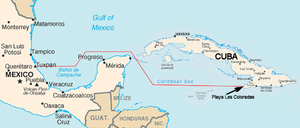Granma (yacht)
 The yacht Granma. |
|
| Career | |
|---|---|
| Name: | Granma |
| General characteristics | |
Granma is the yacht that was used to transport the fighters of the Cuban Revolution from Mexico to Cuba in 1956 for the purpose of overthrowing the regime of Fulgencio Batista. The 60-foot (18 m) diesel-powered cabin cruiser was built in 1943 and designed to accommodate 12 people. It is said to have been named for the original owner's grandmother.[1]
Contents |
Role in the Cuban revolution

| Cuban Revolution |
| Timeline |
| Events |
|---|
| Attack on Moncada Barracks "History Will Absolve Me" speech Granma boat landing Operation Verano Battle of La Plata Battle of Las Mercedes Battle of Yaguajay Battle of Santa Clara |
| General articles |
| 26th of July Movement Radio Rebelde |
| People |
| Fulgencio Batista Fidel Castro - Che Guevara Raúl Castro - Camilo Cienfuegos Frank País - Huber Matos Celia Sánchez - William Morgan Carlos Franqui - Vilma Espín Norberto Collado Abreu Manuel Urrutia |
The yacht was purchased on 10 October 1956 for the amount of MX$50,000 (US$15,000) from the U.S.-based Schuylkill Products Company, Inc. by a Mexican citizen — said to be Mexico City gun dealer Antonio "The Friend" del Conde[2] — secretly representing Fidel Castro. Castro's 26th of July Movement had attempted to purchase a Catalina flying boat or a US naval crash boat for the purpose of crossing the Gulf of Mexico to Cuba, but had been thwarted by lack of funds. The money to purchase the Granma had been raised in the U.S. state of Florida by former President of Cuba Carlos Prío Socarrás.[3]
Shortly after midnight on 25 November 1956 in the Mexican port of Tuxpan, Veracruz, the Granma was surreptitiously boarded by 82 members of the 26th of July movement including their leader, Fidel Castro, his brother, Raúl Castro, Che Guevara and Camilo Cienfuegos. The group — who later came to be known collectively as los expedicionarios del yate Granma — set out from Tuxpan at 1 a.m. and, after a series of vicissitudes and misadventures, including the near-foundering of their heavily overladen and leaking craft, disembarked on the shores of what is now Granma Province on 2 December. The Granma was piloted by Norberto Collado Abreu, a Cuban Navy veteran and ally of Castro.[4] The location was chosen to emulate the voyage of national hero José Martí, who had landed in the same region 61 years earlier during the wars of independence from Spanish colonial rule.
Landing
| “ | We reached solid ground, lost, stumbling along like so many shadows or ghosts marching in response to some obscure psychic impulse. We had been through seven days of constant hunger and sickness during the sea crossing, topped by three still more terrible days on land. Exactly 10 days after our departure from Mexico, during the early morning hours of December 5, following a night-long march interrupted by fainting and frequent rest periods, we reached a spot paradoxically known as Alegría de Pío (Rejoicing of the Pious). | ” |
After the revolution
Soon after the revolutionary forces triumphed on 1 January 1959, the cabin cruiser was transferred to Havana Bay. Norberto Collado Abreu, who had served as main helmsman for the 1956 voyage,[4] was given the responsibility of guarding and preserving the yacht.
Since 1976, the yacht has been on permanent display in a glass enclosure at the Granma Memorial adjacent to the Museum of the Revolution in Havana. A portion of old Oriente Province, where the expedition made landfall, was renamed Granma Province in honor of the vessel and the Landing of the Granma National Park established at the location (Playa Las Coloradas) was declared a World Heritage Site by UNESCO for its natural habitat. Every year on 25 November a group of Cuban youths sets out from Tuxpan aboard a replica of the Granma to re-trace hour by hour the voyage of the original Granma to its landing spot at Playa Las Coloradas a week later.
The date 2 December is celebrated as the "Day of the Cuban Armed Forces",[6] and the replica has also been paraded at state functions to commemorate the original voyage. In further tribute, the official newspaper of the Central Committee of the Cuban Communist Party has been called Granma. The name of this vessel became an icon for Cuban communism. Although the name is sometimes described as having been misspelled, the Shorter Oxford English Dictionary lists granma as a variant of grandma.
References
- ↑ Yahoo news. Accessed 3 December 2006.
°Roots of Cuban Revolution lie in the east. Vanessa Arrington, Associated Press July 2006. Accessed 14 January 2007.
°Time Magazine 1966 report Accessed 3 December 2006. - ↑ Frank Jack Daniel (27 November 2006). "Fifty years on, Mexico town recalls young Castro". Caribbean Net News. http://www.caribbeannetnews.com/cgi-script/csArticles/articles/000044/004447.htm. Retrieved 2007-12-02.
- ↑ Thomas, Hugh. Cuba : The Pursuit of Freedom. p584-5.
- ↑ 4.0 4.1 "Cuban Revolutionary Collado Abreu Dies". Associated Press. 2008-04-03. http://ap.google.com/article/ALeqM5iwmSiVGv7YJhIJt2qN4o-3rWEQ-QD8VQ3DSG0. Retrieved 2008-04-03.
- ↑ Ernesto "Che" Guevara (World Leaders Past & Present), by Douglas Kellner, 1989, Chelsea House Publishers, ISBN 1555468357, pg 40
- ↑ Expedición del Granma Online at Cuban Ministry of the Armed Forces, accessed 19 November 2006
External links
- Che Guevara's account of the Granma's voyage
- Fidel Castro recalls the Granma crossing
- Landing of the Granma on historyofcuba.com
- The Voyage of the Granma
- Che Describes his Departure to Cuba from Mexico Aboard the Granma
|
|||||||||||||||||||||||||||||
